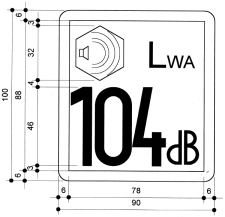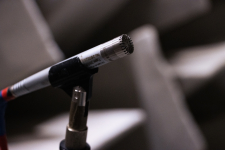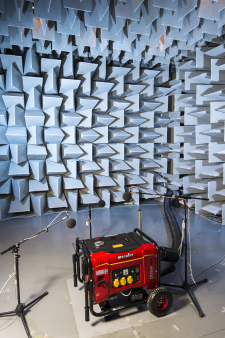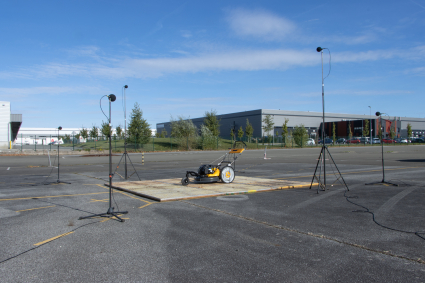
Equipment intended for use outside buildings entering and circulating on the European and UK market is subject to noise emission regulations. Manufacturers are responsible for ensuring that equipment is in conformity with the provisions of these regulations.
Noise emissions regulations
For the European market, the applicable regulations are European Directive 2000/14/EC, amended by Directive 2005/88/EC.
From January 1, 2025, equipment subject to this directive will also have to comply with the equivalent UK legislation: the UK Regulations 2001 No. 170, amended by the Product Safety and Metrology etc. (Amendment etc.) (EU Exit) Regulations 2019.
Manufacturer’s obligations
These two regulations are very similar. To place the equipment onto the market the manufacturers must :
- Guarantee that equipment complies with noise emission regulations.
- Submit the equipment to pass a conformity assessment procedure.
- Affix the CE or UKCA marking and the guaranteed sound power level to the equipment, and draw up a declaration of conformity.
Member States may withdraw non-compliant equipment from the market.



All the concerned products are either listed in Article 12 or Article 13 of Directive 2000/14/EC, equivalent to Schedule 1 and Schedule 2 of UK Regulations 2001 No. 1701.
The equipment listed in Article 12 of the Directive / Schedule 1 of the UK Regulations is subject to noise emission limits and may not circulate on the European market, nor on the UK market, without certification issued by a notified body for the European Union or an approved body for Great Britain.
List of equipment subject to noise emission limits:
| Builders’ hoists for the transport of goods (combustion engine driven) | Compaction machines (only vibrating and non-vibrating rollers, vibratory plates and vibratory rammers) | Compressors (< 350 kW) | Concrete-breakers and picks, hand-held |
| Construction winches (combustion-engine driven) | Dozers (< 500 kW) | Dumpers (< 500 kW) | Excavators, hydraulic or rope-operated (< 500 kW) |
| Excavator-loaders (< 500 kW) | Graders (< 500 kW) | Hydraulic power packs | Landfill compactors, loader-type with bucket (< 500 kW) |
| Lawnmowers (excluding agricultural and forestry equipment, and multi-purpose devices, the main motorised component of which has an installed power of more than 20 kW) | Lawn trimmers/lawn edge trimmers | Lift trucks, combustion-engine driven, counterbalanced (excluding ‘other counterbalanced lift trucks’ as defined in Annex I, item 36, second indent with a rated capacity of not more than 10 tonnes) | Loaders (< 500 kW) |
| Mobile cranes | Motor hoes (< 3 kW)A | Paver-finishers (excluding paver-finishers equipped with a high-compaction screed) | Power generators (< 400 kW) |
| Tower cranes | Welding generators |
Equipment listed in Article 13 of the Directive / Schedule 2 of the UK Regulations is subject to noise marking only.
List of equipment subject only to noise marking:
|
|
Brush cutters | Builders’ hoists for the transport of goods (with electric motor) | Building site band saw machines |
| Building site circular saw benches | Chain saws portable | Combined high pressure flushers and suction vehicles | Compaction machines (explosion rammers only) |
| Concrete or mortar mixers | Construction winches (with electric motor) | Conveying and spraying machines for concrete and mortar | Conveyor belts |
| Cooling equipment on vehicles | Drill rigs | Equipment for loading and unloading silos or tanks on trucks | Glass recycling containers |
| Grass trimmers/grass edge trimmers | Hedge trimmers | High pressure flushers | High pressure water jet machines |
| Hydraulic hammers | Joint cutters | Leaf blowers / leaf collectors | Lift trucks, combustion-engine driven, counterbalanced (only ‘other counterbalanced lift trucks’ as defined in Annex I, item 36, second indent with a rated capacity of not more than 10 tonnes) |
| Mobile waster containers | Paver-finishers (equipped with a high-compaction screed) | Piling equipment | Pipelayers |
| Piste caterpillars | Power generators (≥ 400 kW) | Power sweepers | Refuse collection vehicles |
| Road milling machines | Scarifiers | Shredders/chippers | Snow-removing machines with rotating tools |
| Suction vehicles | Trenchers | Truck mixers | Water pump units (not for use under water) |
Noise emissions measurements

Noise emissions must be measured in accordance with Annex III of the Directive / Schedule 6 of the UK Regulations.
The basic standard for measuring noise emissions is EN ISO 3744:1995. The regulations also define an acoustic test code for each type of equipment.
The guaranteed value of the sound power level to be displayed on the equipment is a value including uncertainties due to production variations and measurement procedures.
Conformity assessment: equipment listed in Article 12 / Schedule 1
For equipment subject to noise emission limit values, an assessment prior to placing on the market and during production must be carried out by a notified body/approved body.
The assessment most commonly carried out is the assessment according to Annex VI of the Directive / Schedule 9 of the UK Regulations: internal control of production with assessment of technical documentation and periodic checking.
Before the 1st item of equipment is placed on the market, the manufacturer shall present a copy of the technical documentation to a notified body/approved body.
The technical documentation contains the following information:
- Administrative and technical information (engine, power, etc.)
- Test report: sound power measurements carried out in accordance with Annex III of the Directive/Schedule 6 of the UK Regulations.
- Evaluation of uncertainties due to production variations and determination of the guaranteed sound power level.
If the documentation complies, the notified body/approved body issues a certificate of conformity. The manufacturer may mark the equipment and issue a CE / UKCA declaration of conformity, for which he will assure full responsibility.
The manufacturer must takes all measures necessary in order that the manufacturing process ensures compliance of the equipment with the technical documentation and with the requirements of the directive and UK regulations.
During production of the equipment, an evaluation must be carried out by the notified body/approved body who signed agreement with the manufacturer.
The manufacturer can choose between two procedures:
- The body carries out periodic checks on the customer's site to verify equipment marking, issuing of the declaration of conformity and the assessment of uncertainties due to production variations.
- The body carries out (or have carried out) product checks at random intervals. The body selects a sample to be measured in accordance with Annex III/Schedule 6, and checks sound level conformity, equipment marking and issuing of the declaration of conformity.
For both procedures, the frequency of checks is defined by the notified body/approved body. The check has to be carried out at least once every three years.
Solutions offered by LNE
LNE and its subsidiary LNE-GMED UK offer a complete range of outdoor equipment assessment services:
- Issuance of CE and UKCA certificates of conformity, in process inspections
- LNE was designated as a Notified Body in 2002 following the implementation of Directive 2000/14/EC (Notified Body number: 0071).
- LNE-GMED UK obtained UKAS accreditation to ISO 17065 and subsequently be appointed as an Approved Body on October 31, 2022 (UKAB 8521).
- Evaluation prior placing on the market and during production are common to both CE and UKCA marking.
- Sound power measurements under COFRAC accreditation*
To carry out noise emission measurements, LNE has several outdoor test runways for bulky equipment, including :- An asphalt runway for most equipment
- A concrete runway for jackhammers or concrete breake
- A wire-mesh runway for container roll-outs
- A measurement hemisphere radius of up to 10 meters
For smaller-volume products (generators, lawnmowers, etc.), LNE has a 110 m3 semi-anechoic room equipped with a gas extraction system.
Conformity testing according to ISO 3744 and Annex III of Directive 2000/14/EC is carried out under COFRAC* accreditation.
*Lists of accreditations, sites and scopes are available at www.cofrac.fr







